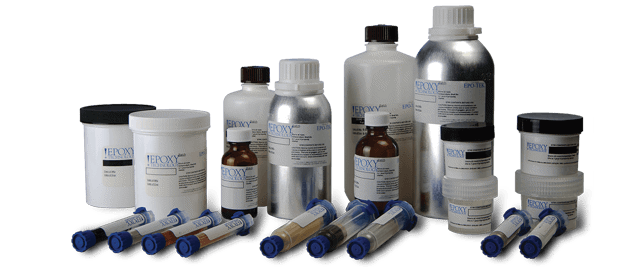
Whenever there is a need for curing and drying of coatings, inks and adhesives, UV curing is used. This use of UVs has eliminated the need for ratio mixing, solvent removal and potential life concern as UV-cured adhesives have become a high-speed replacement for two-part adhesives in many applications. AZoM speaks to Brian Bruce from Epoxy Technology, Inc., about how their specialty UV epoxies hold advantages over UV acrylates.
Can you give a brief overview of your company and the types of products you produce?
Epoxy Technology Inc. (EPO-TEK®) was founded in 1966 and is a leading specialty adhesive manufacturer that provides a full range of high quality epoxy adhesives including, cationic as well as free radical acrylates which support the semiconductor, optoelectronic, medical, automotive, aerospace, photovoltaics, military and electronic assembly markets.
Epoxy Technology is very proud of its recognized quality program, which includes our comprehensive ISO 9001:2015 and MIL STD 883/5011 certifications, as well as RoHS Compliance and Green Partnerships.
Our varied portfolio of adhesives includes electrically conductive, thermally conductive, and optical grade epoxies, as well as UVs, UV Hybrids and custom formulating expertise.

Can you please explain to our readers what UV curing epoxies are?
UV Cationic epoxies are used for both the speed of a UV system curing in 30 seconds to 2 minutes while also offering higher strength than a standard acrylate UV; the most common UV on the market today. UV epoxies react when UV light initiates the photoinitiator package, which generates an epoxy polymerization reaction for various alignment and positioning uses, as well as for bonding and flow control.
What advantages do UV curing epoxies hold over UV acrylate-based epoxies?
Excellent adhesion and reliability, mainly due the properties of an epoxy rather than an acrylate.
The average shrinkage for UV epoxies is around 1-5% while acrylate systems can shrink as much as 10-15%. Low shrinkage leads to low internal stress, which also aids in increasing adhesion and they are not subject to oxygen inhibition. UV epoxies are not quenched by oxygen as occurs with acrylate systems. This could cause the acrylate-based UV to terminate curing early, producing an adhesive to form a tacky surface and poor physical properties.
In addition, UV epoxies are capable of a “dark cure” meaning, the acid initiator generated from the photoinitiator continues to be active, and crosslinking continues even after the UV light is turned off. This allows for a small degree of shadow cure.
How To Properly Mix EPO-TEK Epoxies
How does this benefit members within the industries you serve?
EPO-TEK® UV products offer low shrinkage and sub-micron alignment, for the optoelectronics industries and others where speed and precision are critical.
How do Epoxy Technology’s UV curing epoxies differ from what other companies offer?
With over 50 years of epoxy experience, our formulators have developed unique UV curing epoxies with high strength and reliability – Making ours clearly superior both in reliability and quality!
Which industries are currently benefitting from the services Epoxy Technology provide?
Optoelectronic Applications, Semiconductor, Medical, Fiber Optic Packaging, Sensor Devises and General Electronic Assembly – basically anywhere that parts can be cured using UV light.
How to Properly Handle and Mix an EPO-TEK® Bi-Pack
What’s next for Epoxy Technology?
Epoxy Technology, Inc. continues to develop by adding a new line of UV Hybrid adhesives. Our new UV Hybrid products are based on our widely known and used EPO-TEK® 353ND and 301 product lines and are available in a variety of rheologies.
The UV Hybrid adhesives were created over several years of research along with advances in the industry, this specialty UV Hybrid line allows engineers to reach new levels of production/process improvement, as well as affording greater design flexibility.
UV Hybrid adhesives offer a primary UV cure for tacking, followed by a secondary heat cure for completion. This unique combination affords engineering design in areas, once considered not able to be reached with conventional adhesive material.
We are continually to develop additional UV, UV Hybrids and UV Dual cure systems, to add to our extensive catalog of specialty adhesives.
About Brian Bruce
Brian Bruce is an International Technical Applications Engineer with over 5 years of specialized training and experience in epoxy and UV adhesive applications. He has supported numerous Fortune 500 companies worldwide in their manufacturing assembly and bonding needs.
Mr. Bruce, as a trained adhesives solution provider, has assisted customers through personal visits, presentations, training seminars as well as through targeted technical/application specific correspondence. He holds a Bachelor’s Degree in Chemistry from Wheaton College, receiving an undergraduate award in Analytical Chemistry for his outstanding work.

Disclaimer: The views expressed here are those of the interviewee and do not necessarily represent the views of AZoM.com Limited (T/A) AZoNetwork, the owner and operator of this website. This disclaimer forms part of the Terms and Conditions of use of this website.